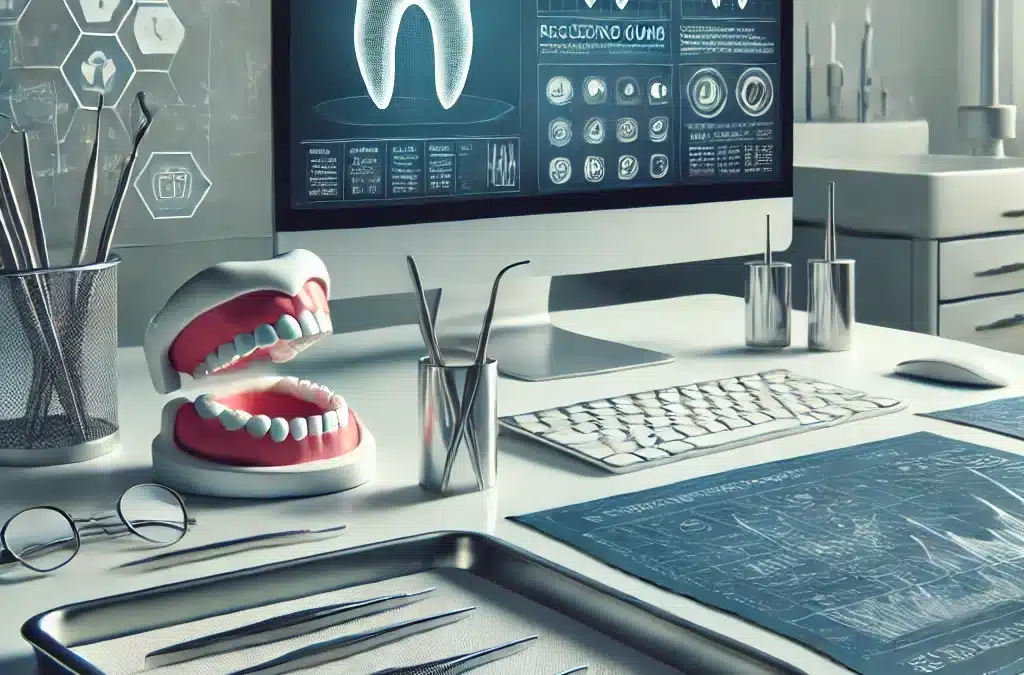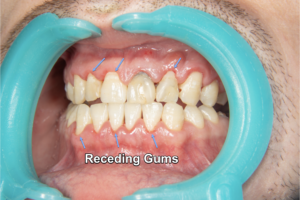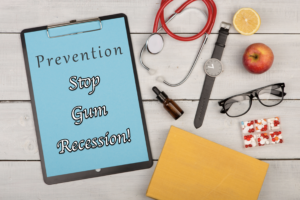Understanding and Managing Receding Gums: A Comprehensive Guide
Receding gums, medically known as gingival recession, is a common dental issue that affects a significant portion of the population. It can lead to sensitivity, pain, and even tooth loss if left untreated. In this comprehensive guide, we’ll explore the causes, symptoms, and treatments for receding gums, empowering you to take control of your oral health.
What Are Receding Gums?
Receding gums occur when the gum tissue surrounding the teeth pulls back or wears away, exposing more of the tooth or its root. This not only leads to aesthetic concerns but also creates gaps where bacteria can gather and potentially cause serious oral health problems.
The Silent Epidemic
Often called a “silent epidemic,” receding gums affect a significant portion of the adult population. According to the American Dental Association, up to 47.2% of adults over 30 have some form of periodontal disease, which is the primary culprit behind gum recession.
Causes of Receding Gums
Several factors can contribute to gum recession:
- Gum Disease: Periodontal disease, including gingivitis and periodontitis, is a leading cause of receding gums. In fact, according to the American Academy of Periodontology, gum disease can result in 30% of adults experiencing some form of gum recession.
- Poor Dental Hygiene: Inadequate brushing and flossing can lead to plaque buildup, causing gums to recede. Simply put, your gums crave attention just like that houseplant you keep forgetting to water – neglect it, and it withers away.
- Aggressive Brushing: Brushing too hard or using a hard-bristled toothbrush can erode gum tissue. Think of your gums as delicate rose petals; they need gentle care, not a heavy-duty scrub. Remember, it’s called “brush your teeth,” not “scrape your teeth.”
- Genetics: Some individuals are genetically predisposed to gum recession. If your family tree has a history of dental issues, it might be time to give extra attention to your gum health.
- Hormonal Changes: Fluctuations in hormones, such as during pregnancy, can make gums more sensitive and prone to recession. This often-overlooked cause highlights how interconnected our body systems are. During these times, extra gentle dental care is paramount.
- Smoking and Tobacco Use: Tobacco products can damage gums and lead to recession. A study published by the Journal of Clinical Periodontology found that smokers are up to six times more likely to develop gum disease compared to non-smokers.
- Teeth Grinding and Clenching: Bruxism exerts excessive force on the gums, leading to recession. This nocturnal habit not only disturbs your sleep but also terrorizes your gums. Consider wearing a night guard and discussing stress-relieving strategies with your dentist.
Maintaining good oral hygiene—such as brushing gently with a soft-bristled toothbrush, flossing daily, and using antimicrobial mouthwash—is crucial. Regular dental check-ups are also essential, as they allow for early detection and management of gum issues before they progress into more severe problems like gum disease and tooth loss. Dentaly.org
Symptoms of Receding Gums
Recognizing the symptoms of receding gums early can make a significant difference in managing and even reversing the condition. Here are some common indicators:
- Sensitivity to hot, cold, or sweet foods and drinks: As the gums recede, the roots of the teeth become exposed, making them more susceptible to temperature changes.
- Visible lengthening of the teeth: As gums retract, more of the tooth is exposed.
- Gum inflammation and swelling: Swollen and inflamed gums are often due to the buildup of plaque and bacteria at the gumline.
- Bad breath: Receding gums can lead to persistent bad breath, a result of bacteria accumulating in the newly created pockets between the gum and tooth.
- Bleeding gums: If your gums bleed even at the gentlest touch of your toothbrush or floss, it’s a typical symptom of gum disease.
According to the American Dental Association, “gingival recession is a condition that affects almost half of adults over the age of 30.” Early detection and intervention are crucial in preventing further damage and promoting healthier gums.
The Latest Research on Receding Gums
Recent scientific breakthroughs are revolutionizing our understanding of receding gums. Researchers have identified a complex interplay of genetic factors, microbiome composition, and systemic health conditions as key contributors to gum recession.
Genetic Predisposition
A study published in the Journal of Dental Research found that individuals with a family history of gum recession are at a higher risk. This genetic component underscores the importance of being proactive about gum health, especially if you have a family history of dental issues.
The Oral Microbiome
Our mouth houses millions of bacteria, forming what’s known as the oral microbiome. Changes in this microbial community can trigger inflammation and contribute to gum recession. Understanding the composition and behavior of the oral microbiome can open new pathways for preventing and treating gum disease.
Systemic Health Connections
Systemic health conditions, especially diabetes, add another layer of complexity. A study by the American Diabetes Association indicates that diabetic individuals are twice as likely to experience periodontal disease compared to non-diabetic patients. This connection emphasizes the importance of managing overall health for maintaining healthy gums.
Cutting-Edge Solutions
Scientists are investigating advanced regenerative techniques and biomaterials to promote tissue regeneration and restore gum health. One promising avenue is the use of peptide-based scaffolds, which have shown great potential in encouraging gum tissue growth.
Treatment Options for Receding Gums
Treatment for receding gums varies based on the severity and underlying cause of the gum recession. Here are some of the most effective options that modern dental science has to offer:
- Scaling and Root Planing: This deep-cleaning method involves removing plaque and tartar below the gum line. According to the American Academy of Periodontology, this procedure can significantly reduce gum inflammation and improve gum attachment to the teeth.
- Gum Grafting: In more severe cases, dental professionals might recommend gum grafting. Tissue is transplanted to cover exposed roots, helping to protect against further decay and sensitivity.
- Regenerative Procedures: These advanced techniques aim to stimulate natural gum growth. Using membranes, tissue-stimulating proteins, or bone grafts, dentists encourage the gum tissue to regenerate. A study in the Journal of Periodontology found that regenerative procedures can significantly reduce the depth of gum pockets and restore bone levels.
- Orthodontics: Sometimes, misaligned teeth can be the secret culprits behind receding gums. Braces or aligners can help correct these issues, distributing bite pressure more evenly and helping to prevent further gum deterioration.
- Laser Treatment: High-tech laser treatments can be used to remove diseased tissue and encourage gum reattachment to the teeth. This minimally invasive option can reduce pain and speed up recovery time.
Natural and Home Remedies
While professional treatments are often necessary, there are several natural and home remedies that can help manage gum recession:
- Maintain Good Oral Hygiene: Gentle brushing and flossing twice daily can stave off plaque build-up. Remember, overzealous brushing (with a hard brush) might actually be part of the problem. A study published in the Journal of Clinical Periodontology found that aggressive brushing is a common cause of gum recession.
- Use a Soft-Bristled Toothbrush and Non-Abrasive Toothpaste: Opt for a soft-bristled toothbrush to gently cleanse without causing harm. Choose non-abrasive toothpaste to avoid contributing to gum erosion.
- Rinse with Natural Mouthwashes: Saline solution can help reduce inflammation and sanitize your mouth. The Journal of Indian Society of Periodontology notes that diluted hydrogen peroxide can also be effective against bacteria responsible for gum disease.
- Apply Essential Oils: Tea tree oil, with its potent antimicrobial and anti-inflammatory properties, can be particularly beneficial. Another study highlighted in the Journal of Periodontology found that patients who used tea tree oil gel experienced a significant reduction in bleeding and inflammation.
Prevention Tips
Preventing gum recession is easier than treating it. Here are some science-backed tips to keep your gumline intact:
- Regular dental check-ups and cleanings: The American Dental Association emphasizes that “Routine dental visits are essential because they detect issues early on before they become major problems.”
- Practice excellent oral hygiene: Effective brushing and flossing play a crucial role in preventing gum diseases like gingivitis, which can lead to receding gums if left untreated.
- Avoid tobacco products: The Centers for Disease Control and Prevention (CDC) note that smokers are twice as likely to have gum disease compared to non-smokers.
- Utilize a balanced diet rich in vitamins and minerals: Good nutrition is essential for gum health. Vitamins C and D, calcium, and other minerals found in a balanced diet can fortify your gums.
- Protect your teeth and gums from injury: If you grind your teeth during sleep or participate in contact sports, a mouthguard can prevent physical damage to your gums.
“The cheapest insurance for your teeth is daily flossing—it’s a simple investment that pays off. And remember, you can’t drink battery acid and expect your teeth to thrive. A healthy diet, along with brushing twice a day and flossing once, is the foundation for a lifetime of dental health.” – Dr. Richard Walicki, General and Cosmetic Dentist
Conclusion
Receding gums can be a troubling condition, but understanding its causes and treatments can empower you to take proactive steps towards maintaining your oral health. The key takeaway? Don’t neglect the symptoms of receding gums. Pain, sensitivity, and the visibility of tooth roots are all signs that need immediate attention.
Preventive measures, such as using a soft-bristled toothbrush and avoiding aggressive brushing, can go a long way in protecting your gumline. Studies also suggest that lifestyle choices, such as a balanced diet and quitting smoking, can significantly reduce the risk of gum disease. Also, routine dental visits are essential because they detect issues early on before they become major problems.
For those already experiencing gum recession, modern dental treatments offer various remedies — from scaling and root planing to laser therapies and even gum grafts. Natural remedies can also play a role in maintaining gum health, but they should complement, not replace, professional dental care.
Remember, an empowered approach today can save not just your gums, but potentially your overall health tomorrow. Stay informed about the latest research and consult with your dental professional to develop a personalized plan for treatment and prevention. Your smile is worth the effort, after all!
* Key preventive steps include:
- Regular dental check-ups
- Using natural remineralizing toothpastes
- Maintaining a balanced diet rich in antioxidants
“An ounce of prevention is worth a pound of cure.” — Benjamin Franklin






